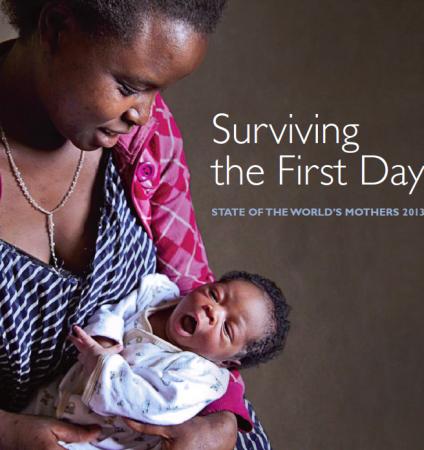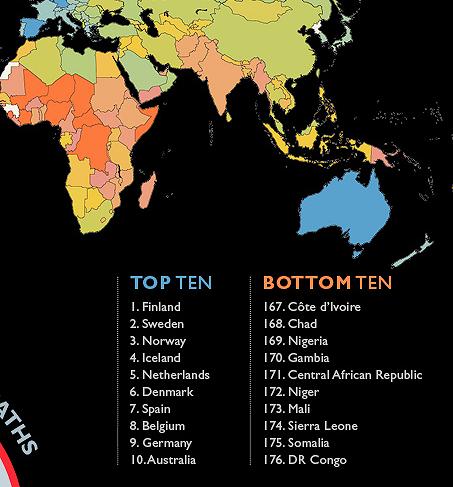|
Thursday August 29, 2013 -
Save the Children report on the State of the World's
Mothers is out and it paints a grim picture of the
survival of babies and mothers all over the world. It is
an indictment on health delivery systems in both
so-called developing and developed countries. Alas our
very own country is again in the bottom rung, never mind
the trumpets of deception that is soothing music to the
ears of the smoke and mirrors occupant of State House.
"More than 1 million babies die on the first day of life
– making the birth day the most dangerous day for babies
in nearly every country, rich and poor alike. This is
one of the major findings of Save the Children’s 14th
annual State of
the World’s Mothers
report.
 
The
findings indicate, as never before, that helping babies
survive the first day – and the first week – of life
represents the greatest remaining challenge in reducing
child mortality and meeting the ambitious Millennium
Development Goal of reducing 1990 child mortality rates
by two-thirds by 2015."...begins the Executive Summary
of the State of the World Mothers Save the Children
Report for 2013. The report covering a wide range of
countries provides a challenge to all health delivery
ministries and organisations to take a good hard look at
how they operate, what they offer to this vital arm of
humanity and we would hope, that will galvanise
governments all over the world into positive action.
Sierra Leone finds itself in the bottom 10 of this
report and rather than have the government's hired hands
polluting the ether with excuses and coming up with
inane imaginations, would be charitable and truthful enough
to see things in their true perspective and state the
truth as it is on the ground. We would suggest the
report be read and appreciated, more so when the report
offers solutions and the way forward in solving such
problems.
We now know that newborn deaths are
not inevitable and that low-income countries can
make significant progress in reducing newborn
mortality. We have identified the three major causes
of these deaths – complications during birth,
prematurity and infections – and we have developed a
set of interventions that can prevent or treat each
of these causes. These proven interventions –
coupled with stronger health systems and sufficient
health care workers who are trained, deployed and
supported to tackle the key causes of child
mortality – have the potential to reduce newborn
deaths by as much as 75 percent. This would save
more than 2 million newborn lives each year. Ending
preventable deaths within a generation will require
an increased focus on the steps needed to reduce
newborn mortality. What is lacking is the political
will and funding to deliver these solutions to all
the mothers and babies who need them.
We are offering these pieces of advice
fully aware that in many an instance, their hired hands,
parading as journalists and what have you would be quick
to jump on the bandwagon of denial and would try to
delve into areas in which they are least competent eg
interpreting statistical data when the government was
slammed in another report some weeks back. We would
advise that in wanting to twist the report to suit the
eyes and ears of their paymaster at State House that
they heed well the repercussions of their joint
enterprise.
An original analysis by Save the
Children estimates that within the first month of
life, more than 1 million babies could be saved each
year with universal access to these products, which
cost between 13 cents and $6 each and are ready for
rapid scale-up now.
The products are: ••steroid
injections for women in preterm labor (to reduce
deaths due to premature babies’ breathing
problems);
••resuscitation
devices (to save babies who do not breathe at
birth);
••chlorhexidine
cord cleansing (to prevent umbilical cord
infections); and
••injectable
antibiotics (to treat newborn sepsis and pneumonia).
Other low-cost interventions such as kangaroo mother
care and early and exclusive breastfeeding would
save many more babies. Such interventions, as part
of strengthened health care systems, not only can
dramatically reduce maternal and newborn deaths, but
also can prevent a lifetime of negative health
consequences such as long-term disabilities,
intellectual impairment and increased vulnerability
to illness. Poor health is not only costly for
individuals and their families, it can also impede a
nation’s efforts toward economic growth.
What this means is that if those
controlling the peoples' purse can take a second look at
this new report, they would easily see that one ticket
and expenses for one member of the many delegations
which use tax payers' money to fly out of the country on
every opportunity, could be used in saving many lives if
such delegations and such overseas visits are
drastically cut back so that the poor and unconnected
would be saved.
The report recommends a number of moves
that could help a country like Sierra Leone raise from
the bottom group position -
Invest in health workers –
especially those working on the front lines – to
reach the most vulnerable mothers and babies.
The world faces a shortage of
5 million health workers of all
types and there is an acute shortage of frontline
health workers, including 350,000
with midwifery skills. New frontline health
workers need to be recruited and
trained, and those who are already practicing
need opportunities to update and
improve their skills.
These health workers
must be part of functioning health
systems, and deployed to serve communities
where they are most needed. Midwives
and birth attendants need training,
supplies and appropriate facilities
to prevent and respond to birth complications.
It is essential that routine
obstetric care includes proven solutions such
as giving corticosteroids to mothers
in preterm labor, which can help infants’
lungs develop so that they can
breathe when they are born. Birth attendants also
need training to help newborn babies
survive the “golden minute” –that first
moment after birth when, if a baby
is not breathing spontaneously, a simple
intervention can save her life.
The ball
is in the court of the Sierra Leone government and its
various operatives as we remind them of this section of
the report's Executive Summary.
"The first day of life
is the most dangerous day for mothers and babies.
Worldwide, the
day a child is born is by far the most dangerous day in
a child’s life. Save the Children’s first-ever
Birth Day Risk Index
compares first-day death rates for 186 countries and
finds that in most countries, children are at greatest
risk on the day they are born.
Babies in Somalia have
the highest risk of dying on their birth day. First-day
death rates are almost as high in Democratic Republic of
the Congo, Mali, and Sierra Leone. Mothers in these four
countries are also at high risk on this day. Mothers in
Somalia and Sierra Leone face the second and third
highest lifetime risk of maternal death in the world,
respectively."
Kindly
note this section of the report in which the United
States also comes under the spotlight -
"In the industrialized world, the
United States has by far the most first-day deaths.
Only 1 percent
of the world’s newborn deaths occur in industrialized countries, but the newborn period is
still the riskiest time, no matter where a baby is born, with the first day being
the riskiest time of all in most, if not all, countries. The United States has the
highest first-day death rate in the industrialized world. An estimated 11,300 newborn babies die each
year in the United States on the day they are born."
|